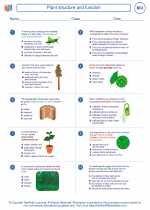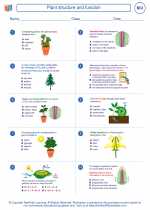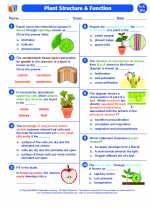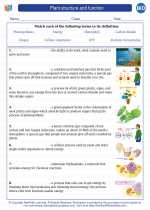Simple Leaves
A simple leaf is a type of leaf in which the blade is undivided, meaning it is not separated into smaller leaflets. Simple leaves have a single, continuous unit of blade, which may be smooth-edged, toothed, lobed, or divided in various ways.
Structure of a Simple Leaf
A simple leaf typically consists of the following parts:
- Blade: The broad, flat, and typically green part of the leaf.
- Petiole: The stalk that attaches the leaf to the stem of the plant.
- Veins: The vascular bundles that provide support and transport nutrients and water throughout the leaf.
- Margin: The edge of the leaf, which can be smooth, serrated, lobed, or otherwise modified.
Functions of Simple Leaves
Simple leaves play crucial roles in the life of a plant, including:
- Photosynthesis: The green pigment chlorophyll in the leaf's cells captures light energy and converts it into chemical energy, which is used to produce food for the plant.
- Gas Exchange: The stomata, tiny pores on the leaf's surface, allow for the exchange of gases such as oxygen and carbon dioxide during photosynthesis and respiration.
- Transpiration: The process by which water evaporates from the leaf's surface, helping to pull water and nutrients up from the roots through the plant's vascular system.
Identification of Simple Leaves
When identifying a leaf as simple, consider the following characteristics:
- Single Blade: Look for a single, undivided blade attached to the petiole.
- No Leaflets: Unlike compound leaves, simple leaves do not have leaflets along the petiole.
- Variations in Shape and Margin: Pay attention to the shape of the blade and the characteristics of its margin, as these can vary widely between plant species.
Study Guide
To study simple leaves effectively, consider the following key points:
- Learn the structure of a simple leaf, including the blade, petiole, veins, and margin.
- Understand the functions of simple leaves in photosynthesis, gas exchange, and transpiration.
- Practice identifying simple leaves by examining various plant specimens and noting their key characteristics.
- Compare and contrast simple leaves with compound leaves to understand their differences.
- Explore the diversity of simple leaves by studying different plant species and noting the variations in leaf shape and margin.
By mastering the structure, functions, and identification of simple leaves, you can gain a deeper understanding of plant biology and the essential role that leaves play in the life of a plant.
[Simple Leaves] Related Worksheets and Study Guides:
.◂Biology Worksheets and Study Guides High School. Plant structure and function
Worksheet/Answer key Plant structure and function
Plant structure and function  Worksheet/Answer key
Worksheet/Answer key Plant structure and function
Plant structure and function  Worksheet/Answer key
Worksheet/Answer key Plant structure and function
Plant structure and function  Worksheet/Answer key
Worksheet/Answer key Plant structure and function
Plant structure and function  Vocabulary/Answer key
Vocabulary/Answer key Plant structure and function
Plant structure and function  Vocabulary/Answer key
Vocabulary/Answer key Plant structure and function
Plant structure and function 

 Worksheet/Answer key
Worksheet/Answer key
 Worksheet/Answer key
Worksheet/Answer key
 Worksheet/Answer key
Worksheet/Answer key
 Vocabulary/Answer key
Vocabulary/Answer key
 Vocabulary/Answer key
Vocabulary/Answer key

The resources above cover the following skills:
Concepts of Life Science (SC1, SC2, SC3)
The student demonstrates an understanding of the structure, function, behavior, development, life cycles, and diversity of living organisms by describing the structure-function relationship